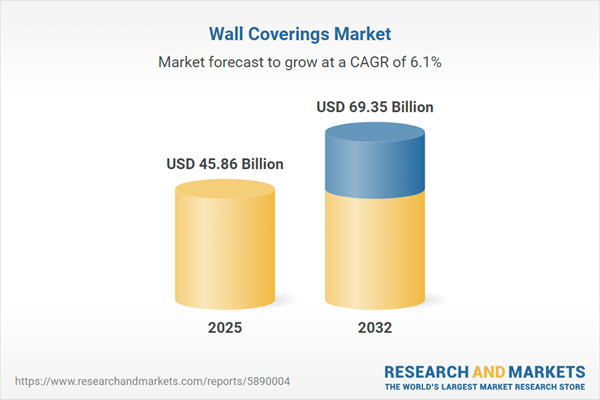Speak directly to the analyst to clarify any post sales queries you may have.
The wall coverings market is undergoing a transformation driven by innovations in materials, the adoption of sustainable practices, and evolving interior design demands, positioning itself as a core element in modern building solutions for commercial and residential settings.
Market Snapshot: Wall Coverings Market Size and Outlook
The wall coverings market grew from USD 43.22 billion in 2024 to USD 45.86 billion in 2025. It is projected to maintain strong momentum at a CAGR of 6.08%, achieving USD 69.35 billion by 2032. Market expansion is being propelled by advances in digital printing technology, increasing regulatory focus on sustainability, and a shift toward multifunctional wall solutions across the globe.
Scope & Segmentation
- Product Type: Fabric, foil, nonwoven (including pre-pasted and unpasted), paper (peelable, strippable, traditional), vinyl (embossed, perforated, smooth)
- Distribution Channel: Dealers and distributors, direct sales, online sales (company websites, e-commerce platforms, marketplaces), retailers (department stores, home improvement stores, specialty stores)
- Application: Commercial (healthcare, hospitality, office, retail), residential (bathroom, bedroom, kitchen and dining, living room)
- End Use: New construction (commercial, residential), renovation (DIY, professional)
- Geographies: Americas (North America—United States, Canada, Mexico; Latin America—Brazil, Argentina, Chile, Colombia, Peru); Europe, Middle East & Africa (Europe—United Kingdom, Germany, France, Russia, Italy, Spain, Netherlands, Sweden, Poland, Switzerland; Middle East—United Arab Emirates, Saudi Arabia, Qatar, Turkey, Israel; Africa—South Africa, Nigeria, Egypt, Kenya); Asia-Pacific (China, India, Japan, Australia, South Korea, Indonesia, Thailand, Malaysia, Singapore, Taiwan)
- Key Players: Ahlstrom-Munksjö Oyj, Freudenberg SE, Berry Global Group, Inc., Arclin, Inc., Grasim Industries Limited, Synthomer PLC, JAF Holdings Co., Ltd., TOLI Corporation, Hanwha L&C Co., Ltd., OMNOVA Solutions, Inc.
- Technologies: Digital and automated printing, advanced surface coatings, nanotechnology, bio-based and recyclable substrates
Key Takeaways for Senior Decision-Makers
- Material innovation is expanding design capabilities, enabling the creation of solutions that blend durability, functional benefits, and sustainability for standout interior environments.
- Sustainability trends are accelerating the adoption of recyclable and low-emission substrates, as stakeholders increasingly prioritize circular economy principles and compliance with eco-regulations.
- Advancements in digital printing and nanotechnology are enabling rapid customization, supporting brands and specifiers in responding quickly to shifting design preferences and technical requirements.
- Blurring boundaries between residential and commercial applications demand solutions evaluated for aesthetics, acoustic performance, cleanability, and regulatory standards, supporting broader occupant wellbeing and brand differentiation.
- Regional diversity shapes market dynamics, from renovation-driven demand in mature markets like North America to urbanization-fueled growth and material experimentation across Asia-Pacific and regions in EMEA.
Tariff Impact and Competitive Strategy
New U.S. tariff measures introduced in 2025 have shifted sourcing decisions, increased import costs, and prompted the search for domestic or tariff-exempt supply options. This has resulted in contract renegotiations, alternative material exploration, and heightened value engineering efforts by brands seeking to absorb rising costs. Companies that use scenario planning and integrate cross-functional teams adapt more swiftly—with innovation in materials and design optimization driving long-term resilience and market relevance.
Research Methodology & Data Sources
This report uses a rigorous methodology that combines qualitative interviews with industry leaders, comprehensive primary data, and detailed secondary analysis. Quantitative validation is achieved through triangulation of import/export records, pricing indexes, and performance metrics, ensuring actionable and reliable insights tailored to sector needs.
Why This Report Matters
- Enables senior executives to anticipate shifts in product demand, supplier landscapes, and regulatory pressures for precise strategic planning.
- Provides a clear framework for leveraging technological advancements and channel strategies to drive growth and competitive differentiation.
- Supports scenario-based planning to mitigate global policy risks and rapidly evolving consumer behaviors.
Conclusion
This analysis offers clarity on the forces redefining the wall coverings market and presents actionable strategies for capturing opportunity amid change. By aligning sustainability, innovation, and operational flexibility, leaders can secure long-term success in a dynamic global environment.
Additional Product Information:
- Purchase of this report includes 1 year online access with quarterly updates.
- This report can be updated on request. Please contact our Customer Experience team using the Ask a Question widget on our website.
Table of Contents
3. Executive Summary
4. Market Overview
7. Cumulative Impact of Artificial Intelligence 2025
Companies Mentioned
The companies profiled in this Wall Coverings market report include:- Ahlstrom-Munksjö Oyj
- Freudenberg SE
- Berry Global Group, Inc.
- Arclin, Inc.
- Grasim Industries Limited
- Synthomer PLC
- JAF Holdings Co., Ltd.
- TOLI Corporation
- Hanwha L&C Co., Ltd.
- OMNOVA Solutions, Inc.
Table Information
| Report Attribute | Details |
|---|---|
| No. of Pages | 185 |
| Published | November 2025 |
| Forecast Period | 2025 - 2032 |
| Estimated Market Value ( USD | $ 45.86 Billion |
| Forecasted Market Value ( USD | $ 69.35 Billion |
| Compound Annual Growth Rate | 6.0% |
| Regions Covered | Global |
| No. of Companies Mentioned | 11 |









